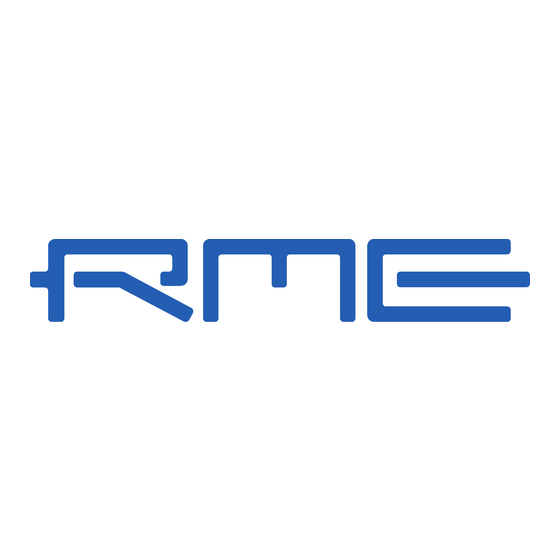Summary of Contents for RME Audio TEB
- Page 1 User's Guide TDIF Expansion Board for DIGI96/8 Series, Hammerfall Series HDSP 9632 and HDSP 9652...
-
Page 2: Table Of Contents
Contents Introduction .............. 3 Package Contents ............ 3 Hardware Requirements........... 3 Technical Specifications........... 4 Hardware Installation..........4 Operation and Usage ..........6 Word Clock .............. 7 Double Speed ............8 Connector Pinout D-sub ........... 8 Warranty ..............9 Appendix..............9 User's Guide TEB... -
Page 3: Introduction
1. Introduction Thank you for choosing the RME EXB technology. The TDIF Expansion Boards adds an 8- channel TDIF interface to all ADAT-capable RME cards. Special features include manual choice of clock reference, status LEDs and a word clock output. -
Page 4: Technical Specifications
4. Technical Specifications TDIF Port: D-sub 25-pin Double Line mode: 4 channels at 88.2 kHz and 96 kHz (not with DIGI96 series) Supported sample rates: 44.1 kHz, 48 kHz, varispeed (33 - 57 kHz) Resolution: 24 bit Word clock out: BNC, low-impedance driver stage, 4 Vss into 75 Ohms, short-circuit-proof Sync source: ADAT (PCI card) or TDIF Power supply uses 3.5"... - Page 5 Connecting a TEB to a DIGI96/8 PRO/PAD Connecting a TEB to a HDSP 9652 User's Guide TEB...
-
Page 6: Operation And Usage
Connecting a TEB to the second ADAT In of a HDSP 9652. Remove the jumper ST5, plug DIGOUT of the TEB on both right and middle pin of ST5. 6. Operation and Usage Switch on the computer and boot the OS. The green LED on the TEB is lit when the power supply is present. -
Page 7: Word Clock
7. Word Clock In the analogue domain one can connect any device to another device, a synchronization is not necessary. Digital audio is different. Correct interpretation of digital audio data is dependent upon a definite sample frequency. Signals can only be correctly processed or transferred be- tween devices if these all share the same clock. -
Page 8: Double Speed
8. Double Speed Sample rates above 48 kHz were not always taken for granted, and are still not widely used because of the CD format (44.1 kHz) dominating everything. Before 1998 there were no re- ceiver/transmitter circuits available that could receive or transmit more than 48 kHz. Therefore a work-around was used: instead of two channels, one AES line only carries one channel, of which the odd and even samples are being distributed to the former left and right channels. -
Page 9: Warranty
Matthias Carstens, 7/2002. Version 1.1 Although the contents of this User’s Guide have been thoroughly checked for errors, RME can not guarantee that it is correct throughout. RME does not accept responsibility for any misleading or incorrect information within this guide. Lending or copying any part of the guide or the RME drivers CD, or any commercial exploitation of these media without express written permission from RME Intelligent Audio Solutions is prohibited. - Page 10 This device has been tested and found to comply with the limits of the European Council Direc- tive on the approximation of the laws of the member states relating to electromagnetic com- patibility (EMVG) according to EN 55022 class B and EN50082-1. FCC Compliance Statement Certified to comply with the limits for a Class B computing device according to subpart J or part 15 of FCC rules.



